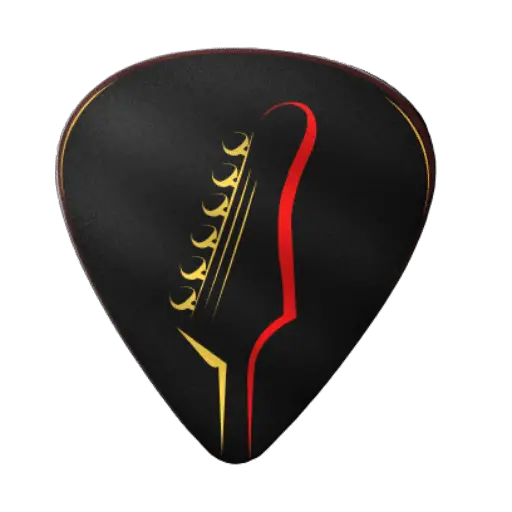Drop B Tuning Six Strings?
In drop B tuning, the lowest string of a six-string guitar—typically the sixth string—is tuned to a B note rather than the conventional E. The remaining strings are often tuned in this tuning in the same order as in standard tuning, which is E-A-D-G-B-E from low to high.
Drop B tuning produces a lower, harder sound best suited for performing heavy metal, hard rock, and other genres that call for a more aggressive, dark tone. Lowering the lowest string to B makes it simpler to play power chords with a rich, deep sound and gives the guitar’s tone a heavier feel. With this tuning, guitarists can explore new creative realms, play with various chord voicings and scales, and produce a richer, more passionate sound for their songs.
Drop B Tuning A 6-String Guitar?
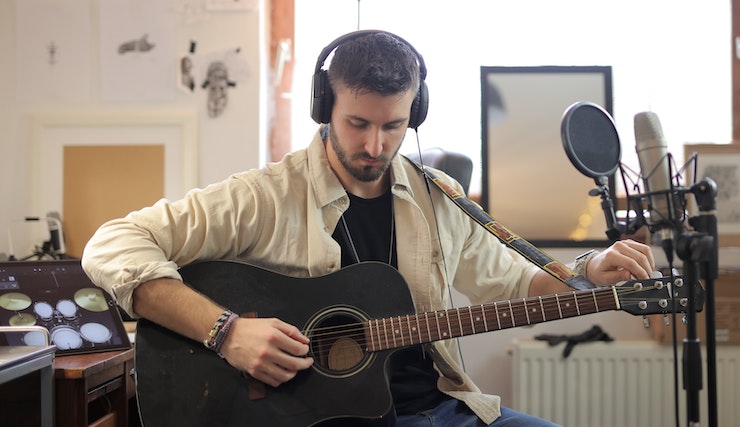
In drop B tuning, the lowest string of a six-string guitar—typically the sixth string—is tuned to a B note rather than the conventional E. This alternate tuning gives guitarists several advantages that can be outlined in more depth.
Lower and Heavier Sound, Number One
Drop B tuning enables a lower and heavier tone by moving the lowest string from E to B. For styles like heavy metal, hard rock, or any other that call for a darker, more aggressive sound, the lower pitch of the B string produces a deeper, more resonant tone. The lower tuning gives the overall guitar sound more weight and intensity.
Improved Power Chords
Power chords are simple to play in drop B tuning. Numerous rock and metal genres frequently include power chords, composed of the root note and the fifth. Guitarists can play power chords with one finger over the lowest two or three strings in drop B tuning because the lower B string is a suitable root note for these chords. This accessibility and simplicity enable more rapid and dynamic chord changes.
Extensive Chord Voicings
Drop B tuning expands the range of possible chord voicings. Guitarists can create original and intriguing chord voicings in the lower tuning by experimenting with alternative fingerings and forms that may not be as accessible in standard tuning. This can result in novel and inventive chord progressions that give compositions depth and intricacy.
More Melodic and Soloing Options
Drop B gives guitarists more choices for soloing and melodic playing due to its lower tuning. Deeper, more aggressive riffs and licks may be played, thanks to the wider range on the lower end. The lower tuning can make reaching specific scales and patterns simpler, facilitating faster and more fluid runs in the guitar’s lower register.
Vocal Range Adaptation
Guitarists playing in drop B tuning sometimes find it helpful when performing with singers with lower voice ranges. Lowering the guitar’s overall pitch simplifies locating chord voicings that fit the singer’s range and improves the tonal harmony between the vocals and the instrument.
Drop B tuning for a six-string guitar produces a lower, heavier sound, improves power chords, broadens chord voicings, provides more soloing options, and may be adjusted to the vocal range when backing singers. Guitarists now have more creative options thanks to this alternative tuning, which enables them to experiment with novel chord progressions, explore various musical genres, and give their music a distinctive depth and intensity.
Drop B Tuning Six-String Gauge
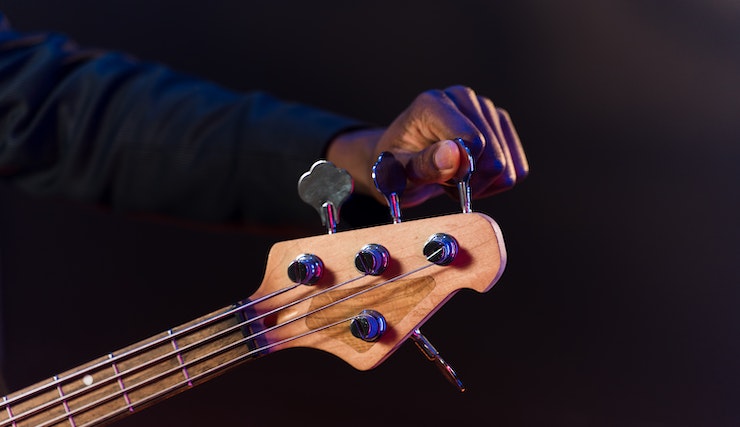
When deciding on the right string gauge for a six-string guitar in drop B tuning, there are several things to consider. The factors to be considered are thoroughly explained in the following points.
Tension and Feeling
The overall string tension is lower in drop B tuning than in conventional tuning because the sixth string is tuned to B. To balance playability and tone quality, it’s crucial to pick a string gauge that offers sufficient tension while also being comfortable to play. While an excessively heavy gauge might make bending and fretting challenging, it may cause floppy strings and poor intonation.
Recommended String Gauge
The normal string gauge recommendations for drop B tuning are 12-60 or 11-56. Accordingly, the first (thinnest) string would be approximate.011 or.012 gauge, while the sixth (heaviest) string would be approximate.056 or.060 gauge. These gauges keep the right tension on the lower strings while allowing enough flexibility to bend and fret the higher strings.
Individual Preference and Playing Method
Playing style and personal preference can also impact the choice of string gauge. Depending on their finger strength, technique, and preferred tone, some guitarists may discover that a lighter or heavier gauge better matches their playing style. To achieve the ideal tonal characteristics in drop B tuning, it’s crucial to experiment with several string gauges to find the one that feels comfortable and allows for the most expressive playing.
Modifications and Setups
It’s important to remember that changing to a heavier gauge in drop B tuning requires modifying the guitar’s setup. The increased string tension may impact the instrument’s neck relief, intonation, and action. To ensure that the instrument is properly set up for the selected string gauge and tuning, allowing for the best playability and tonal performance, it is important to seek the advice of a qualified guitar technician or luthier.
In conclusion, a six-string guitar’s ideal string gauge for drop B tuning depends on various elements, including tension, feel suggestions, personal preference, and playing style. Finding the gauge that balances enough tension with easy playability while getting the ideal tonal qualities is crucial. While a gauge around 12-60 or 11-56 is frequently advised. Additionally, when switching to a heavier gauge in drop B tuning, the guitar’s setup might need to be modified.
Drop B Tuning Six-String Songs?
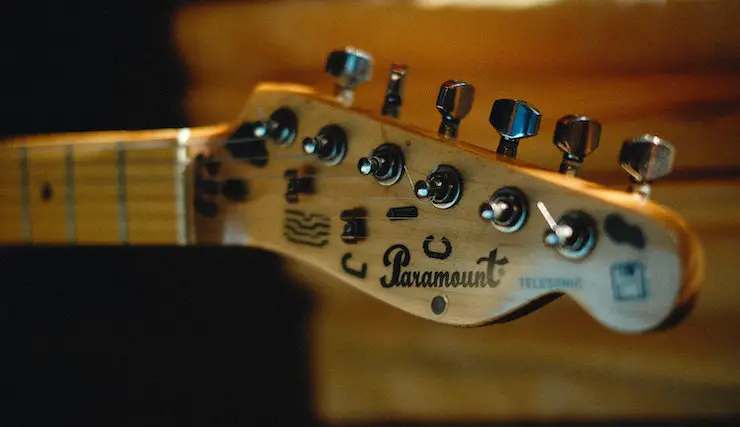
A six-string guitar in drop B tuning offers a plethora of opportunities for playing various tunes in various genres. The kinds of tunes that function well in drop B tuning are explained in depth in the following items.
Hard rock and heavy metal
Drop B tuning is used frequently in the heavy metal and hard rock genres. These genres’ renowned songs frequently use the low, hefty sound that drops B tuning offers. Drop B tuning is used by bands like Pantera, Slipknot, and Lamb of God to produce strong, violent guitar riffs that define their distinct sound. Songs like Pantera’s “Walk” and Slipknot’s “Psychosocial” demonstrate the ferocity and heaviness possible in drop B tuning.
Progressive and Djent Metal
Drop B tuning is frequently used in djent and progressive metal, where complex rhythms and expert guitar playing are prominent. Drop B tuning is well-known for being used by bands like Meshuggah’s and Periphery to produce intricate and polyrhythmic patterns. Meshuggah’s “Bleed” and Periphery’s “Scarlet” are two songs that showcase the detailed and accurate guitar work possible in this tuning.
Alternative and Nu-Metal are two more
The alternative and nu-metal genres have also adopted drop-B tuning because it adds a deeper and heavier tone to the angst-filled music. Drop B tuning has been used by bands like Deftones and Korn to add intensity and depth to their songs. Deftones’ “My Own Summer (Shove It)” and Korn’s “Freak on a Leash” are two songs that demonstrate how melodic and heavy components may coexist in drop B tuning.
Metalcore and Post-Hardcore
Drop B tuning is frequently employed in the metalcore and post-hardcore genres to produce a strong, aggressive tone. In their music, bands like Bring Me the Horizon and Of Mice & Men use Drop B tuning, combining powerful riffs with melodic parts. Drop B tuning in these genres can be heard in songs like “Shadow Moses” by Bring Me the Horizon and “Second & Sebring” by Of Mice & Men.
Progressive and Experimental Rock
Progressive and experimental rock can also use drop B tuning to give unusual compositions a distinctive sound. In their music, bands like Tool and Mastodon use Drop B tuning as they explore intricate rhythms and ethereal textures. Mastodon’s “Blood and Thunder” and Tool’s “Schism” are examples of songs demonstrating the adaptability and artistic potential of drop B tuning in these genres.
A six-string guitar tuned in drop B works well for various songs in the heavy metal, hard rock, djent, progressive metal, alternative, nu-metal, metalcore, post-hardcore, and experimental/progressive rock genres. Drop B tuning produces a lower, heavier sound used in many classic compositions in various genres, allowing for intense guitar riffs, intricate rhythms, and ambient textures.
Drop B Flat Tuning Six-String
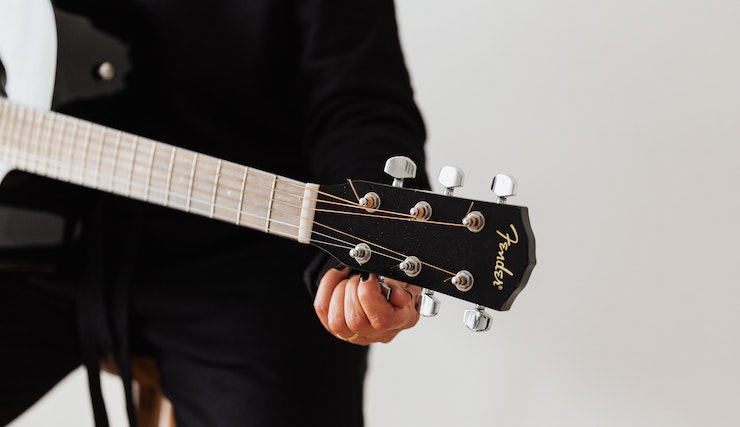
Drop B flat tuning refers to a particular tuning for a six-string guitar in which the lowest string, usually the sixth string, is tuned lower to a B flat (B) note instead of its usual E note. The advantages of this alternative tuning for guitarists are numerous and easily explained.
Lower and Heavier Sound, Number
Unlike conventional tuning, drop B flat tuning produces a lower and heavier tone. The lowest string is tuned to B, lowering the guitar’s overall pitch and producing a richer, resonant tone. Heavy metal, hard rock, and other heavy genres are good fits for this tuning because they call for a darker, more aggressive tone. The guitar’s tone is given more weight and intensity at a lower pitch, which increases the heaviness and force of riffs and chords.
Extended Range
The wider range that drops B flat tuning provides on the guitar’s low end is one of its benefits. Guitarists can access lower notes without using extensive string bending or moving places by lowering the lowest string by a full step to B. This increased range enables the creation of heavier, punchier chord progressions and deeper, more potent riffs.
Power Chord Alterations
Power chord variations, frequently employed in rock and metal music, are made possible by drop B flat tuning. Guitarists can use the low B string to play open-string power chords with a heavier, darker tone and power chords on the sixth string with one finger. These modifications give musicians more alternatives for building powerful, chugging riffs and producing a more aggressive sound.
Simple to Access Lower Tunings
The drop B flat tuning is a starting point for investigating various lower tunings. It becomes simpler to explore with progressively lower tunings once the guitar is tuned down to B by simply detuning individual strings more. This versatility enables guitarists to experiment with different aural environments, develop original chord voicings, and explore genres like doom metal and some metalcore subgenres that use even lower tunings.
Vocal Range Adaptation
Drop B flat tuning might be useful when backing vocalists with lower vocal ranges. Finding chord voicings and melodic motifs that go well with the singer’s lower register is simplified by tuning the guitar lower. This adaptability improves the tonal balance between the vocals and the instrument, creating a seamless and potent musical performance.
An enlarged range for deeper riffs, various power chords, accessibility to lower tunings, and adaptability to voice ranges are all features of drop B flat tuning for a six-string guitar. With this alternative tuning, guitarists can explore new genres, play around with uncommon chord voicings and riffs, and produce more substantial and passionate music.
How To Tune A 6-String?

Each string on a six-string guitar must be tuned to the proper pitch to be in tune. There are various ways to tune a guitar, and the steps below give a thorough breakdown of one popular technique that uses a reference pitch.
Get a reference pitch
You’ll need a reference pitch to tune your guitar correctly. You can tune your instrument with a piano, tuning fork, pitch pipe, digital tuner, or smartphone app. Ensure your reference pitch is tuned to E-A-D-G-B-E, the accepted tuning.
Begin by playing the Low E String
Start by concentrating on the bottom E string, the guitar’s thickest string. Using your chosen device, play the reference pitch and contrast it with the open low E string. The low E string’s tuning peg should be adjusted until it is tuned to the reference pitch.
Set the A, D, and G Strings in tune
Once the low E string is tuned, the other strings can be tuned using the low E string as a reference pitch. Put your finger on the low E string’s fifth fret to play an A note. Play the next thickest string, the A, and adjust the tuning peg until the A string’s pitch corresponds to the low E string’s fifth fret. Follow the same steps for the D and G strings, using the prior string’s fifth fret as the reference pitch.
Tune the B String
Put your finger on the G string’s fourth fret to tune the B string. Play the G string while adjusting the tuning peg until the pitch of the G string matches that of the 4th fret. It is a perfect fourth between the G and B strings.
Adjust the High E String
Finally, place your finger on the B string’s fifth fret to tune the upper E string. Play the B string while adjusting the tuning peg until the pitch of the B string matches that of the fifth fret. A perfect 4th also exists between the B and upper E strings.
Review and adjust
Play chords or individual notes across the fretboard to check for inconsistencies once all the strings have been tuned. Use the appropriate tuning pegs to make small adjustments if any strings sound out of tune until the entire instrument sounds harmonic and in tune.
Remember that frequent tuning maintenance is necessary for the best sound quality. To guarantee precise pitch and a fun playing experience, checking and tuning your guitar frequently is a good idea. Factors like string age, humidity, and playing style can all alter the guitar’s tuning.
FAQ’s
What is drop B tuning on a six-string guitar?
Drop B tuning is a specific tuning for a six-string guitar where the lowest string (usually the thickest) is tuned down to B, resulting in the notes B-E-A-D-G-B from low to high. This tuning allows for a heavy and powerful sound and is popular in various genres such as metal and hard rock.
How do I tune my guitar to drop B tuning?
To tune your guitar to drop B tuning, you will need to adjust the pitch of each string accordingly. Here’s a step-by-step guide:
- Start with your guitar in standard tuning (E-A-D-G-B-E).
- Use a tuner or a reference pitch to lower the sixth (lowest) string from E to B.
- Ensure the remaining strings are still in tune or adjust them as needed.
- You can use an electronic tuner, a tuning app, or tune by ear using a reference pitch.
Do I need to use heavier gauge strings for drop B tuning?
When tuning your guitar to drop B, it is generally recommended to use heavier gauge strings to maintain proper tension and prevent excessive string floppiness. Heavier gauge strings will help retain clarity and avoid intonation issues. Consider trying a set of strings specifically designed for drop tunings or consult with a guitar technician for recommendations based on your playing style and preferences.
Will drop B tuning affect my guitar’s neck or intonation?
Drop B tuning, like any significant change in string tension, can have an impact on your guitar’s neck and intonation. Lowering the overall pitch can cause the neck to bow slightly backward, resulting in a higher action or increased string buzz. It’s advisable to have your guitar properly set up by a professional if you plan on using drop B tuning frequently. This will ensure optimal playability and intonation.
Can I switch between drop B tuning and standard tuning easily?
Switching between drop B tuning and standard tuning requires adjusting the tension of your guitar strings. It may be challenging to alternate between these tunings frequently, as the change in string tension can affect the guitar’s setup and require adjustments each time. Some guitarists choose to dedicate a separate guitar for drop B tuning to avoid the constant adjustments.
Which genres commonly use drop B tuning?
Drop B tuning is particularly popular in heavy metal, metalcore, and other heavy rock genres. Many bands and guitarists incorporate this tuning to achieve a deep and aggressive sound. Notable examples include bands like Slipknot, Korn, and Lamb of God, among others. However, it’s worth noting that tuning preferences can vary among guitarists, and drop B tuning is not limited to specific genres.
Drop B Tuning Six Strings?
In drop B tuning, the lowest string of a six-string guitar—typically the sixth string—is tuned to a B note rather than the conventional E. The remaining strings are often tuned in this tuning in the same order as in standard tuning, which is E-A-D-G-B-E from low to high.
Drop B tuning produces a lower, harder sound best suited for performing heavy metal, hard rock, and other genres that call for a more aggressive, dark tone. Lowering the lowest string to B makes it simpler to play power chords with a rich, deep sound and gives the guitar’s tone a heavier feel. With this tuning, guitarists can explore new creative realms, play with various chord voicings and scales, and produce a richer, more passionate sound for their songs.
Drop B Tuning A 6-String Guitar?

In drop B tuning, the lowest string of a six-string guitar—typically the sixth string—is tuned to a B note rather than the conventional E. This alternate tuning gives guitarists several advantages that can be outlined in more depth.
Lower and Heavier Sound, Number One
Drop B tuning enables a lower and heavier tone by moving the lowest string from E to B. For styles like heavy metal, hard rock, or any other that call for a darker, more aggressive sound, the lower pitch of the B string produces a deeper, more resonant tone. The lower tuning gives the overall guitar sound more weight and intensity.
Improved Power Chords
Power chords are simple to play in drop B tuning. Numerous rock and metal genres frequently include power chords, composed of the root note and the fifth. Guitarists can play power chords with one finger over the lowest two or three strings in drop B tuning because the lower B string is a suitable root note for these chords. This accessibility and simplicity enable more rapid and dynamic chord changes.
Extensive Chord Voicings
Drop B tuning expands the range of possible chord voicings. Guitarists can create original and intriguing chord voicings in the lower tuning by experimenting with alternative fingerings and forms that may not be as accessible in standard tuning. This can result in novel and inventive chord progressions that give compositions depth and intricacy.
More Melodic and Soloing Options
Drop B gives guitarists more choices for soloing and melodic playing due to its lower tuning. Deeper, more aggressive riffs and licks may be played, thanks to the wider range on the lower end. The lower tuning can make reaching specific scales and patterns simpler, facilitating faster and more fluid runs in the guitar’s lower register.
Vocal Range Adaptation
Guitarists playing in drop B tuning sometimes find it helpful when performing with singers with lower voice ranges. Lowering the guitar’s overall pitch simplifies locating chord voicings that fit the singer’s range and improves the tonal harmony between the vocals and the instrument.
Drop B tuning for a six-string guitar produces a lower, heavier sound, improves power chords, broadens chord voicings, provides more soloing options, and may be adjusted to the vocal range when backing singers. Guitarists now have more creative options thanks to this alternative tuning, which enables them to experiment with novel chord progressions, explore various musical genres, and give their music a distinctive depth and intensity.
Drop B Tuning Six-String Gauge

When deciding on the right string gauge for a six-string guitar in drop B tuning, there are several things to consider. The factors to be considered are thoroughly explained in the following points.
Tension and Feeling
The overall string tension is lower in drop B tuning than in conventional tuning because the sixth string is tuned to B. To balance playability and tone quality, it’s crucial to pick a string gauge that offers sufficient tension while also being comfortable to play. While an excessively heavy gauge might make bending and fretting challenging, it may cause floppy strings and poor intonation.
Recommended String Gauge
The normal string gauge recommendations for drop B tuning are 12-60 or 11-56. Accordingly, the first (thinnest) string would be approximate.011 or.012 gauge, while the sixth (heaviest) string would be approximate.056 or.060 gauge. These gauges keep the right tension on the lower strings while allowing enough flexibility to bend and fret the higher strings.
Individual Preference and Playing Method
Playing style and personal preference can also impact the choice of string gauge. Depending on their finger strength, technique, and preferred tone, some guitarists may discover that a lighter or heavier gauge better matches their playing style. To achieve the ideal tonal characteristics in drop B tuning, it’s crucial to experiment with several string gauges to find the one that feels comfortable and allows for the most expressive playing.
Modifications and Setups
It’s important to remember that changing to a heavier gauge in drop B tuning requires modifying the guitar’s setup. The increased string tension may impact the instrument’s neck relief, intonation, and action. To ensure that the instrument is properly set up for the selected string gauge and tuning, allowing for the best playability and tonal performance, it is important to seek the advice of a qualified guitar technician or luthier.
In conclusion, a six-string guitar’s ideal string gauge for drop B tuning depends on various elements, including tension, feel suggestions, personal preference, and playing style. Finding the gauge that balances enough tension with easy playability while getting the ideal tonal qualities is crucial. While a gauge around 12-60 or 11-56 is frequently advised. Additionally, when switching to a heavier gauge in drop B tuning, the guitar’s setup might need to be modified.
Drop B Tuning Six-String Songs?

A six-string guitar in drop B tuning offers a plethora of opportunities for playing various tunes in various genres. The kinds of tunes that function well in drop B tuning are explained in depth in the following items.
Hard rock and heavy metal
Drop B tuning is used frequently in the heavy metal and hard rock genres. These genres’ renowned songs frequently use the low, hefty sound that drops B tuning offers. Drop B tuning is used by bands like Pantera, Slipknot, and Lamb of God to produce strong, violent guitar riffs that define their distinct sound. Songs like Pantera’s “Walk” and Slipknot’s “Psychosocial” demonstrate the ferocity and heaviness possible in drop B tuning.
Progressive and Djent Metal
Drop B tuning is frequently used in djent and progressive metal, where complex rhythms and expert guitar playing are prominent. Drop B tuning is well-known for being used by bands like Meshuggah’s and Periphery to produce intricate and polyrhythmic patterns. Meshuggah’s “Bleed” and Periphery’s “Scarlet” are two songs that showcase the detailed and accurate guitar work possible in this tuning.
Alternative and Nu-Metal are two more
The alternative and nu-metal genres have also adopted drop-B tuning because it adds a deeper and heavier tone to the angst-filled music. Drop B tuning has been used by bands like Deftones and Korn to add intensity and depth to their songs. Deftones’ “My Own Summer (Shove It)” and Korn’s “Freak on a Leash” are two songs that demonstrate how melodic and heavy components may coexist in drop B tuning.
Metalcore and Post-Hardcore
Drop B tuning is frequently employed in the metalcore and post-hardcore genres to produce a strong, aggressive tone. In their music, bands like Bring Me the Horizon and Of Mice & Men use Drop B tuning, combining powerful riffs with melodic parts. Drop B tuning in these genres can be heard in songs like “Shadow Moses” by Bring Me the Horizon and “Second & Sebring” by Of Mice & Men.
Progressive and Experimental Rock
Progressive and experimental rock can also use drop B tuning to give unusual compositions a distinctive sound. In their music, bands like Tool and Mastodon use Drop B tuning as they explore intricate rhythms and ethereal textures. Mastodon’s “Blood and Thunder” and Tool’s “Schism” are examples of songs demonstrating the adaptability and artistic potential of drop B tuning in these genres.
A six-string guitar tuned in drop B works well for various songs in the heavy metal, hard rock, djent, progressive metal, alternative, nu-metal, metalcore, post-hardcore, and experimental/progressive rock genres. Drop B tuning produces a lower, heavier sound used in many classic compositions in various genres, allowing for intense guitar riffs, intricate rhythms, and ambient textures.
Drop B Flat Tuning Six-String

Drop B flat tuning refers to a particular tuning for a six-string guitar in which the lowest string, usually the sixth string, is tuned lower to a B flat (B) note instead of its usual E note. The advantages of this alternative tuning for guitarists are numerous and easily explained.
Lower and Heavier Sound, Number
Unlike conventional tuning, drop B flat tuning produces a lower and heavier tone. The lowest string is tuned to B, lowering the guitar’s overall pitch and producing a richer, resonant tone. Heavy metal, hard rock, and other heavy genres are good fits for this tuning because they call for a darker, more aggressive tone. The guitar’s tone is given more weight and intensity at a lower pitch, which increases the heaviness and force of riffs and chords.
Extended Range
The wider range that drops B flat tuning provides on the guitar’s low end is one of its benefits. Guitarists can access lower notes without using extensive string bending or moving places by lowering the lowest string by a full step to B. This increased range enables the creation of heavier, punchier chord progressions and deeper, more potent riffs.
Power Chord Alterations
Power chord variations, frequently employed in rock and metal music, are made possible by drop B flat tuning. Guitarists can use the low B string to play open-string power chords with a heavier, darker tone and power chords on the sixth string with one finger. These modifications give musicians more alternatives for building powerful, chugging riffs and producing a more aggressive sound.
Simple to Access Lower Tunings
The drop B flat tuning is a starting point for investigating various lower tunings. It becomes simpler to explore with progressively lower tunings once the guitar is tuned down to B by simply detuning individual strings more. This versatility enables guitarists to experiment with different aural environments, develop original chord voicings, and explore genres like doom metal and some metalcore subgenres that use even lower tunings.
Vocal Range Adaptation
Drop B flat tuning might be useful when backing vocalists with lower vocal ranges. Finding chord voicings and melodic motifs that go well with the singer’s lower register is simplified by tuning the guitar lower. This adaptability improves the tonal balance between the vocals and the instrument, creating a seamless and potent musical performance.
An enlarged range for deeper riffs, various power chords, accessibility to lower tunings, and adaptability to voice ranges are all features of drop B flat tuning for a six-string guitar. With this alternative tuning, guitarists can explore new genres, play around with uncommon chord voicings and riffs, and produce more substantial and passionate music.
How To Tune A 6-String?

Each string on a six-string guitar must be tuned to the proper pitch to be in tune. There are various ways to tune a guitar, and the steps below give a thorough breakdown of one popular technique that uses a reference pitch.
Get a reference pitch
You’ll need a reference pitch to tune your guitar correctly. You can tune your instrument with a piano, tuning fork, pitch pipe, digital tuner, or smartphone app. Ensure your reference pitch is tuned to E-A-D-G-B-E, the accepted tuning.
Begin by playing the Low E String
Start by concentrating on the bottom E string, the guitar’s thickest string. Using your chosen device, play the reference pitch and contrast it with the open low E string. The low E string’s tuning peg should be adjusted until it is tuned to the reference pitch.
Set the A, D, and G Strings in tune
Once the low E string is tuned, the other strings can be tuned using the low E string as a reference pitch. Put your finger on the low E string’s fifth fret to play an A note. Play the next thickest string, the A, and adjust the tuning peg until the A string’s pitch corresponds to the low E string’s fifth fret. Follow the same steps for the D and G strings, using the prior string’s fifth fret as the reference pitch.
Tune the B String
Put your finger on the G string’s fourth fret to tune the B string. Play the G string while adjusting the tuning peg until the pitch of the G string matches that of the 4th fret. It is a perfect fourth between the G and B strings.
Adjust the High E String
Finally, place your finger on the B string’s fifth fret to tune the upper E string. Play the B string while adjusting the tuning peg until the pitch of the B string matches that of the fifth fret. A perfect 4th also exists between the B and upper E strings.
Review and adjust
Play chords or individual notes across the fretboard to check for inconsistencies once all the strings have been tuned. Use the appropriate tuning pegs to make small adjustments if any strings sound out of tune until the entire instrument sounds harmonic and in tune.
Remember that frequent tuning maintenance is necessary for the best sound quality. To guarantee precise pitch and a fun playing experience, checking and tuning your guitar frequently is a good idea. Factors like string age, humidity, and playing style can all alter the guitar’s tuning.
FAQ’s
What is drop B tuning on a six-string guitar?
Drop B tuning is a specific tuning for a six-string guitar where the lowest string (usually the thickest) is tuned down to B, resulting in the notes B-E-A-D-G-B from low to high. This tuning allows for a heavy and powerful sound and is popular in various genres such as metal and hard rock.
How do I tune my guitar to drop B tuning?
To tune your guitar to drop B tuning, you will need to adjust the pitch of each string accordingly. Here’s a step-by-step guide:
- Start with your guitar in standard tuning (E-A-D-G-B-E).
- Use a tuner or a reference pitch to lower the sixth (lowest) string from E to B.
- Ensure the remaining strings are still in tune or adjust them as needed.
- You can use an electronic tuner, a tuning app, or tune by ear using a reference pitch.
Do I need to use heavier gauge strings for drop B tuning?
When tuning your guitar to drop B, it is generally recommended to use heavier gauge strings to maintain proper tension and prevent excessive string floppiness. Heavier gauge strings will help retain clarity and avoid intonation issues. Consider trying a set of strings specifically designed for drop tunings or consult with a guitar technician for recommendations based on your playing style and preferences.
Will drop B tuning affect my guitar’s neck or intonation?
Drop B tuning, like any significant change in string tension, can have an impact on your guitar’s neck and intonation. Lowering the overall pitch can cause the neck to bow slightly backward, resulting in a higher action or increased string buzz. It’s advisable to have your guitar properly set up by a professional if you plan on using drop B tuning frequently. This will ensure optimal playability and intonation.
Can I switch between drop B tuning and standard tuning easily?
Switching between drop B tuning and standard tuning requires adjusting the tension of your guitar strings. It may be challenging to alternate between these tunings frequently, as the change in string tension can affect the guitar’s setup and require adjustments each time. Some guitarists choose to dedicate a separate guitar for drop B tuning to avoid the constant adjustments.
Which genres commonly use drop B tuning?
Drop B tuning is particularly popular in heavy metal, metalcore, and other heavy rock genres. Many bands and guitarists incorporate this tuning to achieve a deep and aggressive sound. Notable examples include bands like Slipknot, Korn, and Lamb of God, among others. However, it’s worth noting that tuning preferences can vary among guitarists, and drop B tuning is not limited to specific genres.
